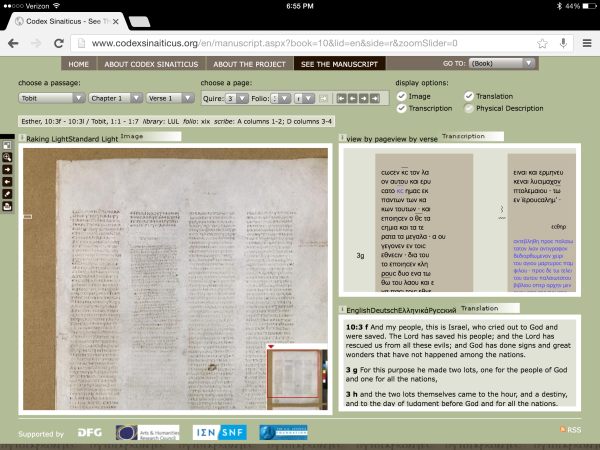Over a decade ago, in a piece called Bibles du Jour, and more recently in his 2011 book, The Rise and Fall of the Bible, Tim Beal invites us to consider the role of media and book culture in shaping the cultural capital operative in ideas of bible.
From a different angle, questions of the relationship between book media and bible are also raised by the massive undertaking of the Codex Sinaiticus Project, a collaborative effort to digitize a stunningly beautiful fourth century C.E. codex manuscript containing many texts that are found in christian bibles purchased in stores today.
 In 2011, I had the privilege of participating in a panel discussion on bible and technology which included both Tim Beal and Juan Garcés, the curator of the Codex Siniaticus Project. I remember being deeply impressed by the acumen and grace of Beal and intimidated by the sheer magnitude of the siniaticus project and the confidence of its curator. Yet, even then, a suspicion was growing in me that the codex as a cultural form, expressed grandly in both the sinaiticus project and the dominant ideas of bible in the contemporary marketplace, has remained largely unquestioned in its potential tendency toward totalization and even dehumanization.
In 2011, I had the privilege of participating in a panel discussion on bible and technology which included both Tim Beal and Juan Garcés, the curator of the Codex Siniaticus Project. I remember being deeply impressed by the acumen and grace of Beal and intimidated by the sheer magnitude of the siniaticus project and the confidence of its curator. Yet, even then, a suspicion was growing in me that the codex as a cultural form, expressed grandly in both the sinaiticus project and the dominant ideas of bible in the contemporary marketplace, has remained largely unquestioned in its potential tendency toward totalization and even dehumanization.
Does a project like the digitization of Codex Sinaiticus offer an opportunity to explore the cracks in the binding of this ancient codex in a new way? In what ways might a codex sensibility be reinscribed even through these exciting new technologies? The project nicely highlights the importance of Codex Sinaiticus as a window into the important conversations and revisions that happen in the margins of these ancient books. Yet, to what degree do the XML encoding schemes and even the lighting techniques used for digitization, reinforce a preference for an original text of “the oldest bible,” as the tagline of their main page reads?
This project, a proximate bible, hopes to play around in the spaces and cracks of things like the codex sinaiticus project to explore the intimate relationship between bible, technology, and meaning.
Sarah Pessin has helped me better imagine this playing around as a ‘difficult curiosity,’ with emphasis on the difficult.
Danny Yencich rasied some fantastic questions in response to this post (see below in the disqus commenting area for his comment in context):
 Danny’s questioning of the materiality on offer in the codex sinaiticus project reminds me that materialities are always multiple. What kind of materiality or access to materiality does the complex montage interface of the Codex Sinaiticus Project offer with the detached pages, transcriptions, and english translations? In what ways does an interface like this resist or erase other materialities? Does the deep encoding involved in the Codex Sinaiticus Project overly textualize and/or commodify this ancient manuscript? Are there different materialities offered by three major manuscript digitization projects?
Danny’s questioning of the materiality on offer in the codex sinaiticus project reminds me that materialities are always multiple. What kind of materiality or access to materiality does the complex montage interface of the Codex Sinaiticus Project offer with the detached pages, transcriptions, and english translations? In what ways does an interface like this resist or erase other materialities? Does the deep encoding involved in the Codex Sinaiticus Project overly textualize and/or commodify this ancient manuscript? Are there different materialities offered by three major manuscript digitization projects?
- Codex Sinaiticus
- Codex Bezae
- Codex Ephraemi Rescriptus - also available through the gallicabnf iOS app
What assumptions do each of these technologies signal and what kinds of reading dispositions might they encourage? How would you teach using these tools? What would you signal regarding the importance of the many media layers at work?